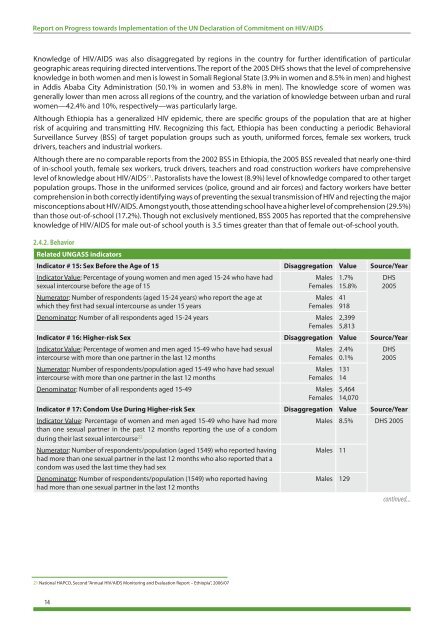Ethiopia - Country Progress Report - unaids
Ethiopia - Country Progress Report - unaids
Ethiopia - Country Progress Report - unaids
Create successful ePaper yourself
Turn your PDF publications into a flip-book with our unique Google optimized e-Paper software.
<strong>Report</strong> on <strong>Progress</strong> towards Implementation of the UN Declaration of Commitment on HIV/AIDS<br />
Knowledge of HIV/AIDS was also disaggregated by regions in the country for further identification of particular<br />
geographic areas requiring directed interventions. The report of the 2005 DHS shows that the level of comprehensive<br />
knowledge in both women and men is lowest in Somali Regional State (3.9% in women and 8.5% in men) and highest<br />
in Addis Ababa City Administration (50.1% in women and 53.8% in men). The knowledge score of women was<br />
generally lower than men across all regions of the country, and the variation of knowledge between urban and rural<br />
women—42.4% and 10%, respectively—was particularly large.<br />
Although <strong>Ethiopia</strong> has a generalized HIV epidemic, there are specific groups of the population that are at higher<br />
risk of acquiring and transmitting HIV. Recognizing this fact, <strong>Ethiopia</strong> has been conducting a periodic Behavioral<br />
Surveillance Survey (BSS) of target population groups such as youth, uniformed forces, female sex workers, truck<br />
drivers, teachers and industrial workers.<br />
Although there are no comparable reports from the 2002 BSS in <strong>Ethiopia</strong>, the 2005 BSS revealed that nearly one-third<br />
of in-school youth, female sex workers, truck drivers, teachers and road construction workers have comprehensive<br />
level of knowledge about HIV/AIDS 21 . Pastoralists have the lowest (8.9%) level of knowledge compared to other target<br />
population groups. Those in the uniformed services (police, ground and air forces) and factory workers have better<br />
comprehension in both correctly identifying ways of preventing the sexual transmission of HIV and rejecting the major<br />
misconceptions about HIV/AIDS. Amongst youth, those attending school have a higher level of comprehension (29.5%)<br />
than those out-of-school (17.2%). Though not exclusively mentioned, BSS 2005 has reported that the comprehensive<br />
knowledge of HIV/AIDS for male out-of school youth is 3.5 times greater than that of female out-of-school youth.<br />
2.4.2. Behavior<br />
Related UNGASS indicators<br />
Indicator # 15: Sex Before the Age of 15 Disaggregation Value Source/Year<br />
Indicator Value: Percentage of young women and men aged 15-24 who have had<br />
sexual intercourse before the age of 15<br />
Numerator: Number of respondents (aged 15-24 years) who report the age at<br />
which they first had sexual intercourse as under 15 years<br />
Denominator: Number of all respondents aged 15-24 years<br />
Males<br />
Females<br />
Males<br />
Females<br />
Males<br />
Females<br />
1.7%<br />
15.8%<br />
41<br />
918<br />
2,399<br />
5,813<br />
Indicator # 16: Higher-risk Sex Disaggregation Value Source/Year<br />
Indicator Value: Percentage of women and men aged 15-49 who have had sexual<br />
intercourse with more than one partner in the last 12 months<br />
Numerator: Number of respondents/population aged 15-49 who have had sexual<br />
intercourse with more than one partner in the last 12 months<br />
Denominator: Number of all respondents aged 15-49<br />
Males<br />
Females<br />
Males<br />
Females<br />
Males<br />
Females<br />
2.4%<br />
0.1%<br />
131<br />
14<br />
5,464<br />
14,070<br />
Indicator # 17: Condom Use During Higher-risk Sex Disaggregation Value Source/Year<br />
Indicator Value: Percentage of women and men aged 15-49 who have had more<br />
Males 8.5% DHS 2005<br />
during their last sexual intercourse 22<br />
than one sexual partner in the past 12 months reporting the use of a condom<br />
Numerator: Number of respondents/population (aged 1549) who reported having<br />
had more than one sexual partner in the last 12 months who also reported that a<br />
condom was used the last time they had sex<br />
Denominator: Number of respondents/population (1549) who reported having<br />
had more than one sexual partner in the last 12 months<br />
Males 11<br />
Males 129<br />
DHS<br />
2005<br />
DHS<br />
2005<br />
continued...<br />
21 National HAPCO, Second “Annual HIV/AIDS Monitoring and Evaluation <strong>Report</strong> – <strong>Ethiopia</strong>”, 2006/07<br />
14

















